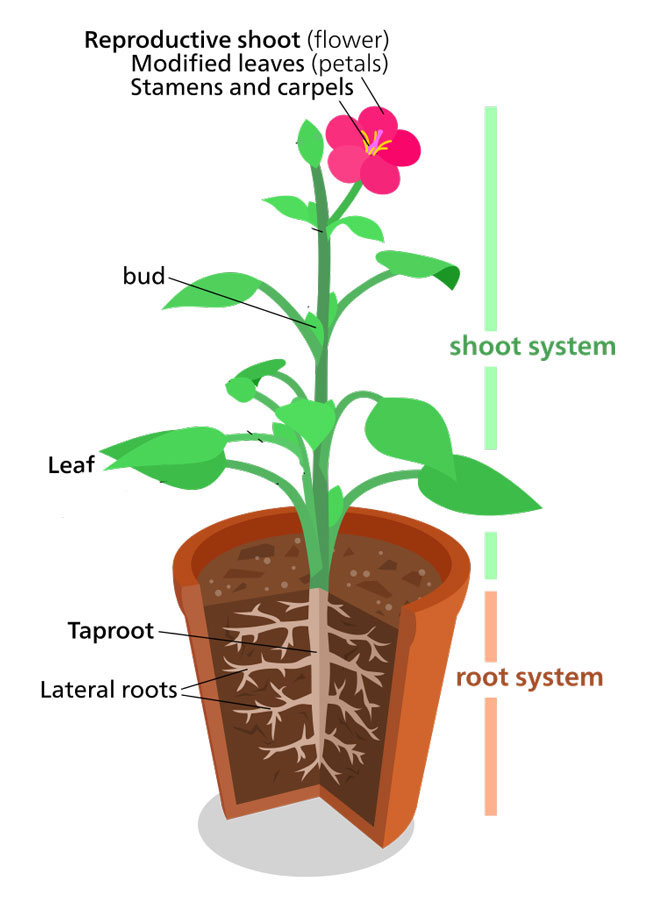 There is a large variety of plants with different sets of structures. However, these plants can be categorized into vascular plants and non-vascular plants. Vascular plants have a system of special tissue called the xylem and phloem. These tissues transport water and other nutrients throughout the plant. You can consider the purpose of these tissues to be similar to the blood vessels of animals.
There is a large variety of plants with different sets of structures. However, these plants can be categorized into vascular plants and non-vascular plants. Vascular plants have a system of special tissue called the xylem and phloem. These tissues transport water and other nutrients throughout the plant. You can consider the purpose of these tissues to be similar to the blood vessels of animals.
The non-vascular plants don’t have xylem and phloem and their structure is different. Here we will be covering the structure of vascular plants for easy understanding.
Roots
Roots are the part of a plant that are buried in the soil. They grow out of the seeds during germination. Roots perform very important tasks, which include:
- Absorbing the water and the necessary nutrients from the soil and sending them to different parts of the plant through special tissues called the xylem and phloem.
- Roots provide a good grip on the stem of a plant so that it can bear its weight and withstand winds.
- Some specialized plants store the food in their roots for later use. Examples of these plants are carrots and potatoes.
Stems
 Stems are connected with the roots and grow outside the soil. All the parts of the plants are connected to the stems. When a plant is young, its stems are green. But as they grow older, their stems turn their color and also become hard. Stem performs many functions, which include:
Stems are connected with the roots and grow outside the soil. All the parts of the plants are connected to the stems. When a plant is young, its stems are green. But as they grow older, their stems turn their color and also become hard. Stem performs many functions, which include:
- It provides support to the leaves, flowers, and fruits.
- It carries the water and nutrient absorbed by the roots to all parts of a plant.
- Stems also store food in many plants, e.g. sugar cane.
Buds
 Buds look like a bump on the stem of a plant. These are the developing shoots, which later become the branches of a plant.
Buds look like a bump on the stem of a plant. These are the developing shoots, which later become the branches of a plant.
Leaves
 Leaves are an important part of the plants mostly having green color (not all plants have green-colored leaves). They contain chlorophyll which gives green color to leaves and absorbs energy from sunlight to make food. The food is prepared in the leaves in a process called photosynthesis. In this process, plants take carbon dioxide gas from the air and light from the Sun to make food. Also, they produce oxygen for us to breathe as a byproduct of photosynthesis.
Leaves are an important part of the plants mostly having green color (not all plants have green-colored leaves). They contain chlorophyll which gives green color to leaves and absorbs energy from sunlight to make food. The food is prepared in the leaves in a process called photosynthesis. In this process, plants take carbon dioxide gas from the air and light from the Sun to make food. Also, they produce oxygen for us to breathe as a byproduct of photosynthesis.
Flowers
 When the plants become mature, they produce flowers (only flowering plants produce flowers). Flowers have beautiful colors and attractive fragrances. They play an important role in the reproduction of flowering plants. When the pollination happens in the flower, it turns into seeds or fruits.
When the plants become mature, they produce flowers (only flowering plants produce flowers). Flowers have beautiful colors and attractive fragrances. They play an important role in the reproduction of flowering plants. When the pollination happens in the flower, it turns into seeds or fruits.
Fruits

Fruits are the parts of plants that are produced after pollination. They contain the seeds of the plants inside. The fruits are made when the female parts of a flower are pollinated. Making delicious fruits is the strategy used by plants to disperse their seeds to different locations. Because fruits are delicious, when animals and humans eat them, they will through their seeds on the land.
Facts
- Flowers have eye-catching colors and good smells to attract insects and animals to carry their pollen from the male part to the female part.
- Humans use around 2,000 different species of plants in their food.
- Some plants eat insects as their food. These plants are called carnivorous plants.





